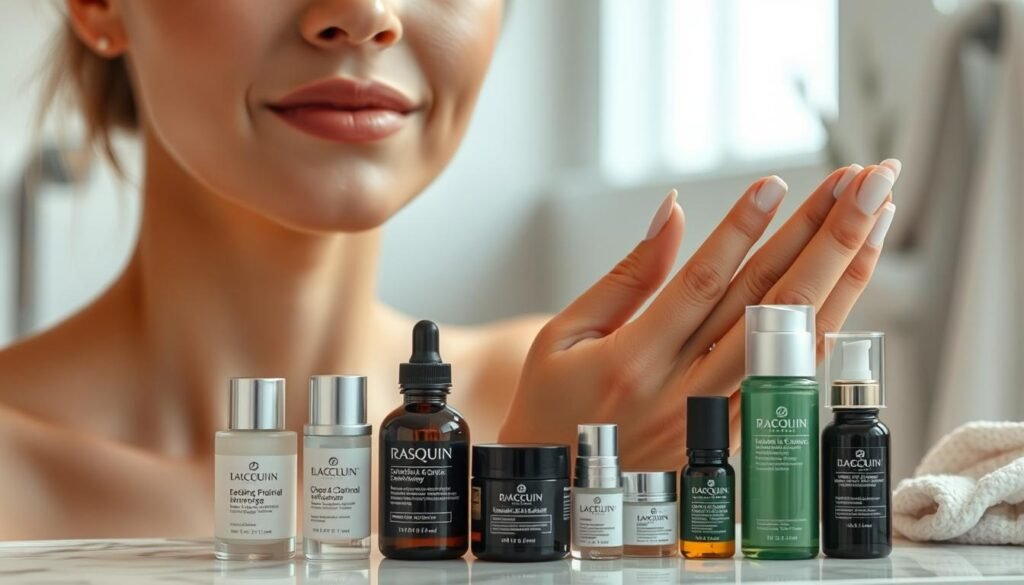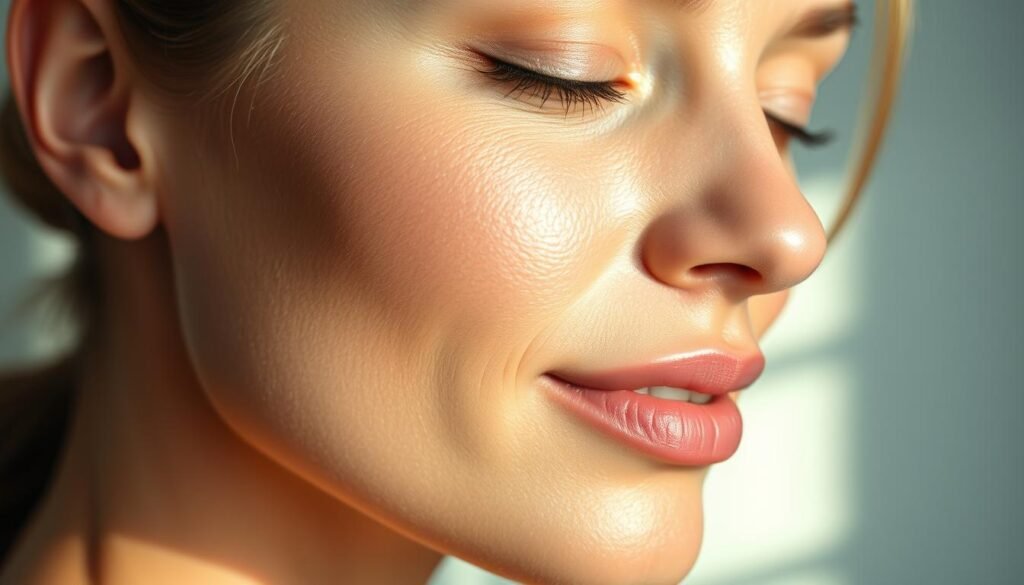As you age, your skin changes a lot. This can cause wrinkles, fine lines, and a loss of glow. Did you know that by the age of 40, most people experience a significant decline in collagen production, leading to visible signs of aging? That’s where youthful skin care comes in, helping you keep your skin looking healthy and bright.
Good anti-aging skincare is more than just looking young. It’s about keeping your skin healthy and strong. By picking the right skincare routine and products for your skin, you can make your skin look better and last longer.
Key Takeaways
- Understanding the importance of collagen in maintaining youthful skin.
- Learning how to choose the right skincare products for your skin type.
- Discovering effective skincare routines to prevent signs of aging.
- Exploring the benefits of a consistent skincare regimen.
- Identifying key ingredients in anti-aging skincare products.
Understanding Skin Aging: Causes and Signs
It’s important to know why and how skin ages to make the best skincare choices. Skin aging is a complex process. It’s influenced by both inside and outside factors.
The Science Behind Skin Aging
Skin aging happens naturally as we get older. It’s because our skin’s ability to repair itself gets weaker. This leads to signs of aging we can see.
The aging process changes the skin in several ways. These include:
- Reduced collagen production
- Decreased elastin levels
- Thinning of the epidermis
- Loss of skin hydration
Common Signs of Aging Skin
Aging skin shows signs like fine lines, wrinkles, and age spots. These signs can be more noticeable around the eyes and mouth.
Internal vs. External Aging Factors
The aging process is shaped by both inside and outside factors. Knowing the difference helps us fight aging better.
Intrinsic Aging Factors
Intrinsic factors include genetics and natural aging. Genetics greatly affect how our skin ages. They influence things like skin elasticity and collagen production.
Extrinsic Aging Factors
Extrinsic factors are lifestyle choices and environmental exposures. Things like UV radiation, smoking, and pollution can speed up aging. This leads to early signs of aging.
To fight skin aging, we need to tackle both inside and outside factors. A good skincare routine should include anti-aging treatments and age-defying products.
Essential Anti-Aging Skincare Ingredients
Discover the powerful ingredients changing anti-aging skincare. As we age, our skin changes, leading to wrinkles and loss of elasticity. But, with the right ingredients, you can fight aging signs and keep your skin glowing.
Retinoids: The Gold Standard
Retinoids come from vitamin A and are top in anti-aging skincare. They boost cell turnover, reduce wrinkles, and improve skin texture. Products with retinoids, like retinol, are great for aging skin. They also fade age spots and hyperpigmentation, making your skin tone even.
“Retinoids are among the most well-studied anti-aging ingredients, with a substantial body of evidence supporting their efficacy.”
Antioxidants: Your Skin’s Defense System
Antioxidants protect your skin from damage and stress. Vitamin C, vitamin E, and ferulic acid are strong antioxidants. They fight free radicals, reducing aging signs and keeping your skin healthy.
- Vitamin C: Boosts collagen and brightens the skin
- Vitamin E: Enhances skin’s natural barrier and moisturizes
- Ferulic Acid: Stabilizes vitamins C and E, making them more effective
Peptides and Growth Factors
Peptides are amino acid chains that boost collagen and skin elasticity. Growth factors are proteins that help cells renew, making your skin look younger. Peptides and growth factors improve wrinkles and fine lines.
| Ingredient | Benefits |
|---|---|
| Peptides | Stimulate collagen production, improve skin elasticity |
| Growth Factors | Promote cellular renewal, enhance skin texture |
Hydrating and Barrier-Supporting Ingredients
Keeping your skin hydrated is key to looking young. Hyaluronic acid and ceramides are essential for moisture and skin barrier.
Hyaluronic Acid and Ceramides
Hyaluronic acid holds up to 1000 times its weight in water, making it a great humectant. Ceramides repair the skin’s barrier. Together, they keep your skin hydrated and healthy.
Niacinamide improves skin elasticity, brightness, and reduces inflammation. Glycerin is another humectant that retains moisture. Products with niacinamide and glycerin make your skin smoother and brighter.
Adding these anti-aging ingredients to your skincare routine fights aging signs and keeps you looking young. Remember, consistency and science-backed products are key to successful anti-aging skincare.
Building Your Anti-Aging Skincare Routine
To fight aging signs, you need a consistent skincare plan. A good routine tackles issues like wrinkles, skin color, and firmness.
Morning Routine Steps
Start your day with the right skincare steps. Your morning routine should include gentle cleansing, applying serums, and moisturizing with sun protection.
Gentle Cleansing Techniques
Begin with a gentle cleanser that removes overnight dirt without drying your skin. Choose a cleanser that fits your skin type, whether it’s dry, oily, or a mix.
Applying Serums and Treatments
After cleansing, use a serum or treatment that targets your aging issues. Retinoids or peptides are great for reducing wrinkles.
Moisturizing and Sun Protection
End with a moisturizer that hydrates and protects from the sun. Use a broad-spectrum sunscreen with at least SPF 30 to shield your skin.

Evening Routine Steps
Your evening routine repairs and rejuvenates your skin. It includes deep cleansing, treatment products, and intense hydration.
Double Cleansing Method
Begin with a double cleansing method. Use an oil-based cleanser followed by a water-based one to remove makeup and impurities.
Treatment Products Application
Apply treatment products with active ingredients like retinoids, peptides, or antioxidants. They address your aging concerns.
Night Repair and Hydration
End with a night cream or moisturizer for deep hydration and repair. Look for hyaluronic acid or ceramides to lock in moisture.
Weekly Treatments and Exfoliation
Weekly treatments and exfoliation boost your skin’s look. This includes chemical exfoliants, masks, and intensive treatments.
Chemical Exfoliants
Use a chemical exfoliant with AHAs or BHAs one to three times a week. It gently removes dead skin cells and boosts cell turnover.
Masks and Intensive Treatments
Apply a face mask or intensive treatment once or twice a week. Choose a mask that fits your skin concerns for extra benefits.
Advanced Anti-Aging Skincare Treatments and Technologies
To improve your skincare, try advanced treatments and technologies. They can make your skin look better than basic routines. These solutions tackle issues that simple skincare can’t.
Professional Treatments Worth Considering
Professional treatments give strong anti-aging benefits. They often work better than products you buy yourself. Here are some top treatments:
- Chemical Peels: These peels remove the skin’s top layers. This reveals smoother, less wrinkled skin.
- Microdermabrasion: A gentle exfoliating treatment. It removes dead skin cells, improving skin texture.
- Laser Treatments: Laser therapy targets wrinkles, age spots, and skin elasticity loss.
- Radiofrequency: This non-surgical treatment heats the dermis. It stimulates collagen and tightens the skin.
Chemical Peels and Microdermabrasion
Chemical peels and microdermabrasion are great for skin rejuvenation. Peels can be light or deep, depending on the solution. Microdermabrasion is gentler and more frequent for skin health.
Laser Treatments and Radiofrequency
Laser treatments and radiofrequency are advanced for aging signs. Lasers target specific issues like pigmentation or fine lines. Radiofrequency tightens the skin and improves texture without surgery.
At-Home Devices for Anti-Aging
At-home devices are popular for their ease and results. They include LED light therapy masks and microcurrent devices. These devices stimulate muscles and improve skin elasticity.
Customizing Treatments for Your Skin Type
It’s important to tailor your treatments to your skin type and concerns. This applies to both professional treatments and at-home devices.
Dry and Sensitive Skin Approaches
For dry and sensitive skin, choose gentle, hydrating treatments. Use chemical peels and microdermabrasion carefully. Tailor laser treatments to avoid irritation.
Oily and Combination Skin Solutions
Oily and combination skin types need treatments that control oil and reduce pores. Laser treatments and radiofrequency are good options. Regular exfoliation and deep cleansing also help.
Knowing your skin type and using the right treatments can give you a youthful look. Combine professional treatments with at-home care for the best results.
Conclusion: Embracing a Holistic Approach to Youthful Skin
To keep your skin looking young, you need more than just anti-aging products. Knowing why and how skin ages helps you pick the right skincare. This way, you can target your specific skin concerns.
It’s important to mix good skincare habits, the right products, and healthy living. Using key anti-aging ingredients like retinoids and antioxidants daily is key. They fight off aging signs.
Adding advanced treatments and tech, like professional services and home devices, boosts your skincare. A complete skincare plan leads to glowing, youthful skin.
Everyone’s skincare journey is different. What works for one might not for another. Be patient, stay consistent, and get expert advice to reach your youthful skin goals.
FAQ
What are the most effective anti-aging skincare ingredients?
The top anti-aging ingredients include retinoids, antioxidants, peptides, and hydrators. Retinoids, from vitamin A, boost cell turnover and collagen. Antioxidants like vitamin C and ferulic acid shield the skin from damage.
Peptides help make more collagen. Hyaluronic acid and ceramides keep the skin’s barrier strong.
How do I build an effective anti-aging skincare routine?
Start with a gentle cleanser and a toner to balance your skin. Use a serum with anti-aging ingredients like retinoids or peptides. Finish with a moisturizer to keep your skin hydrated.
Apply a broad-spectrum sunscreen with at least SPF 30 daily. Exfoliate once a week to remove dead skin and boost cell turnover.
What is the difference between intrinsic and extrinsic aging factors?
Intrinsic aging is the natural process, influenced by genetics and hormones. Extrinsic aging is caused by external factors like UV rays, smoking, and pollution. Knowing the difference helps you focus your skincare routine on your specific needs.
Are at-home devices effective for anti-aging skincare?
Yes, devices like LED masks and microcurrent tools can be helpful. They stimulate collagen, improve texture, and reduce wrinkles when used regularly as part of a complete skincare routine.
How often should I exfoliate my skin as part of my anti-aging skincare routine?
Exfoliation frequency depends on your skin and concerns. Exfoliating once to three times a week can clear dead skin, enhance texture, and reduce wrinkles. But be careful not to overdo it to avoid irritation and dryness.
Can I customize anti-aging treatments for my skin type?
Yes, you can tailor treatments to your skin. Talk to a dermatologist or skincare expert to find the best treatments for you. They can suggest chemical peels, laser therapy, and products that fit your skin type.



